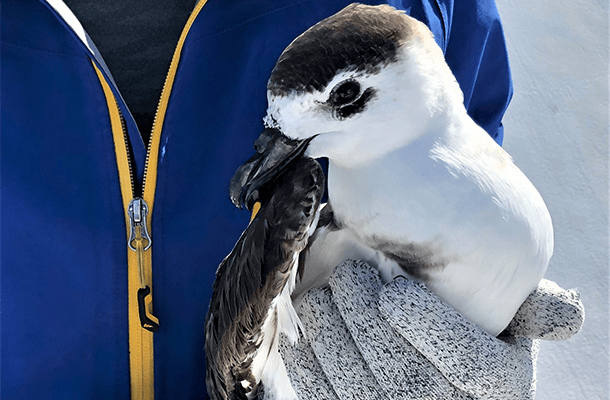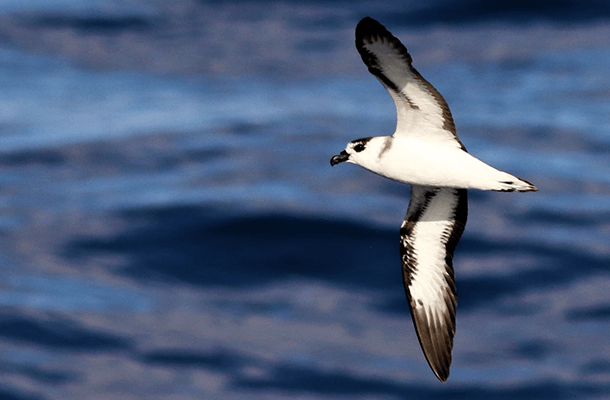Historic First for Mysterious Seabird Achieved with Net Launcher, Perseverance, and Chum
Media Contact: Jordan Rutter, Director of Public Relations, 202-888-7472 | jerutter@abcbirds.org
Expert Contact: Brad Keitt, Oceans and Islands Program Director, 831-420-7115 | bkeitt@abcbirds.org

This Black-capped Petrel, captured and released with a satellite tag, is a white-faced morph. Scientists hope that by tracking these rare, poorly known birds, they will locate new nesting areas they can target for conservation. Photo by Daniel Lebbin
(Washington, D.C., May 22, 2019) An international team of seabird experts brought together by American Bird Conservancy (ABC) has captured Black-capped Petrels at sea for the first time and outfitted the endangered birds with satellite transmitters. Ten Black-capped Petrels were measured, banded, and released with transmitters between May 8 and 14. This groundbreaking work is part of a larger effort to better understand the distribution — and prevent the extinction — of the “Diablotín,” or “little devil,” as this bird is known on its Caribbean nesting grounds. (See regular updates about the satellite-tagged birds on an interactive map.)
“It is quite remarkable to think that you can head 30 miles offshore and expect an endangered seabird to fly within 10 feet of you — close enough to catch with a net,” says Brad Keitt, ABC's Ocean and Islands Program Director. “Some said it couldn't be done, and to be honest, we were all concerned that we might be disappointed.”
The team took advantage of the birds' highly developed sense of smell, which leads Black-capped Petrels to far-off foraging opportunities – in this case, a floating cage packed with “chum,” a pungent and thawing block of fish guts. Then it was just a matter of waiting for the birds to arrive.
“Now that we have shown this can be done,” says Keitt, “it opens the door to more research on other endangered petrel species.”
Aboard a small inflatable boat, the two-person capture team negotiated the rough Gulf Stream waters off the coast of North Carolina. Once the bait attracted the petrels, a custom-made net launcher was used to capture the birds in mid-air.

A white-faced morph Black-capped Petrel at the edge of the continental shelf, 30 miles off Cape Hatteras. Photo by Daniel Lebbin
“These seabirds spend most of their lives at sea, flying over the open ocean in search of food,” says Patrick Jodice, South Carolina Cooperative Fish and Wildlife Research Unit – U.S. Geological Survey (USGS). “These tags will tell us which parts of the ocean these birds use, which in turn will help us understand the threats they face while at sea. We hope that the petrels might lead us to undiscovered nesting sites on new islands.”
Just five breeding sites for the Black-capped Petrel are currently known, all on the island of Hispaniola (three in Haiti, two in the Dominican Republic). Radar surveys strongly suggest that the species breeds on Dominica as well, and scientists remain hopeful that birds may also breed on other islands such as Jamaica and Cuba.
“If we can find new nest sites, we can deal with the threats these birds face and boost breeding success,” says Hannah Nevins, ABC's Seabird Program Director and Co-Chair of the International Black-capped Petrel Conservation Group. “There are not many of these birds remaining, and they are declining. In addition to outright loss of habitat, the birds also suffer from forest fires and predation by invasive species at their island breeding sites.”
Yvan Satgé of the South Carolina Cooperative Fish and Wildlife Research Unit – Clemson University adds: “The few nests we have observed with remote cameras in the Dominican Republic are often visited by mongooses or other introduced predators, such as cats and rats. It is critical that we act quickly and step up conservation at the known nesting sites, as well as any new sites we discover as part of this study.”
The Black-capped Petrel is ranked as Endangered by the International Union for Conservation of Nature (IUCN) and proposed for listing as Threatened under the U.S. Endangered Species Act. The species was feared extinct until its rediscovery in 1963; today, the population is estimated at between 1,000 and 2,000 birds.
See regular updates about the satellite-tagged Black-capped Petrels on an interactive map accessible online. (Webpage URL: https://www.atlanticseabirds.org/bcpe-2019)
The name “Diablotín” originated from the birds' moaning call, which can be heard only at night when the birds visit their nesting grounds. "This is an amazing bird all around,” says Jennifer Wheeler, Co-Chair of the International Black-capped Petrel Conservation Group and with the group BirdsCaribbean. “The world thought it extinct, yet this bird has hung on in Haiti, a country facing overwhelming environmental degradation. It is a symbol of persistence and hope. It is tremendously exciting to think that this project may lead to undiscovered breeding areas for the species and new opportunities to engage in on-the-ground conservation activities to benefit it.”
New Zealand-Aotearoa-based bird conservationist Chris Gaskin, who operated the net gun, adds: “These birds are exquisitely adapted to their marine environment. Their long wings catch the slightest of breeze and they travel effortlessly across thousands of kilometers of ocean, using the winds and waves to propel them with barely any flapping. Having the privilege of holding these birds in your hands gives you an appreciation for both their fragility and their strength.” Black-capped Petrels weigh less than a pound but have over a three-foot wingspan. Their bills are strong and sharp, and the claws on their webbed feet are built to dig into the ground to excavate their nest burrows.
Black-capped Petrels vary in the amount of white and black feathering on their heads and range from white-faced to dark-faced birds. These color morphs may represent two different subspecies or even distinct species. Little is known about the white-faced birds, including where they nest: To date, none of the nests found on the island of Hispaniola have been of fully white-faced birds, leading some to wonder if these birds nest on other islands. Of the ten tagged birds, one was intermediate in plumage, five were dark-faced, and four were white-faced – providing an excellent opportunity to learn if the different color morphs represent distinct breeding populations.
The expedition was led by Brad Keitt, Director of ABC's Oceans and Islands Program, and included Patrick Jodice (USGS) and Yvan Satgé (Clemson University) of the South Carolina Cooperative Fish and Wildlife Research Unit. Jodice and Satgé, who hold the research permits necessary to handle Black-capped Petrels, were in charge of the health and safety of the birds and deploying satellite transmitters. Chris Gaskin captured the petrels using an air-powered net launcher. Brian Patteson and Kate Sutherland of Seabirding Pelagic Trips, who have 30 years' experience leading pelagic seabird tours out of Hatteras, North Carolina, guided the team aboard the Stormy Petrel II to the best areas to find Black-capped Petrels.
Other participants were Daniel Lebbin (ABC's Vice President of Threatened Species), Scott Hall (Senior Scientist for the National Fish and Wildlife Foundation), and Jennifer Wheeler (Black-capped Petrel Working Group Co-Chair, BirdsCaribbean).
The tracking of Black-capped Petrels captured at sea is an exciting advancement on prior collaborative efforts. In 2014, a team comprising the local organization Grupo Jaragua, ABC, and the USGS tagged and tracked dark-faced birds captured at breeding colonies in the Dominican Republic, leading to new information about the species at sea. For example, several of the birds spent a significant amount of time off the coast of Colombia and in the southwestern Caribbean, an area where the birds had not been reported before.
ABC works with partners to protect and minimize threats at breeding areas for Black-capped Petrels and continues to urge the United States to sign on to the international
Agreement on the Conservation of Albatrosses and Petrels (ACAP), which works to coordinate activities that benefit these birds.
ABC is grateful to the Mohamed bin Zayed Species Conservation Fund for their major support of this research expedition.
If you are interested in this research and Black-capped Petrel conservation, please consider supporting ABC's work on this species by donating online.
###
American Bird Conservancy is a nonprofit organization dedicated to conserving birds and their habitats throughout the Americas. With an emphasis on achieving results and working in partnership, we take on the greatest problems facing birds today, innovating and building on rapid advancements in science to halt extinctions, protect habitats, eliminate threats, and build capacity for bird conservation. Find us on abcbirds.org, Facebook, Instagram, and Twitter (@abcbirds).


















































